DRUYA
From: http://shtetle.co.il/Shtetls/drua/drua_eng.html
Three different people are remembering the days of their youth, the war and the tragedy of the ghetto in Druya. This is a look at one and the same event from different angles. Perhaps, due to the time that has passed, there can be some discrepancies in details. In the middle of the 90’s, when I was interviewing these people, it was already 50 years after the days when the ghetto was exterminated.

Synagogue in Druya. Photo by Y. Bulgak. 1928.
Galina Ivanovna Urbin witnessed the event, Joseph Sosnovik and Abram Brio participated in the tragic events.
It seemed to me important to reflect all the three stories without making any corrections.
Memories of Urbin Galina Ivanovna
In July, 1941, literally one week after Germans invaded Druya, they issued an order, which stated that all Jews were to wear yellow tabs on their backs.
In 1942 Jews were prohibited to leave the local ghetto. There was a new order, which allowed Jews to walk in specific places. The ghetto was located around a synagogue. It was a place, which had previously been populated by many Jews and where they kept shops. It was located on a territory from the Druika River to modern shops. While Jews had some gold, they were kept in the ghetto. That gold prolonged their lives for a while. As soon as the gold ran out, they were killed. Druya had some rich Jews.
Roselman was in wholesale.
Sherman worked in wholesale, too.
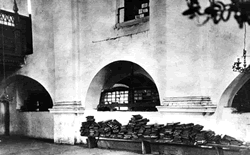
Synagogue in Druya. Photo by Y. Bulgak. 1928.
Murdinsky was a very rich businessman.
Seliber was a doctor, a very popular person. His sister, Rosa Seliber, was a teacher.
Taits-Kalmanovich ran away from the ghetto, was wounded on the leg. He hid in a trench and was soon found by locals, who helped him get to partisans. There his leg was amputated. He lived in Druya after the war. He was the last Jew to live in Druya.
The execution of the Druya ghetto began at 4 or 5 a.m. I don’t remember. Cars with Germans were driving along our street. Father said: “Probably they are going to kill Jews.” We knew that Jews in the neighboring settlements had been executed. When the cars drove up to the square, Germans began to surround the ghetto. The ring was tightening.
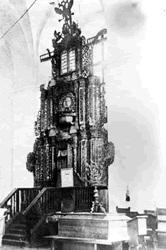
Synagogue in Druya.
Photo by Y. Bulgak. 1928.
Jews set the ghetto on fire by themselves. The synagogue was burning. They say, people were scattering in different directions in chaos.
They say that Bobka Zaidlin was the one who started the fire. Before the war he had owned a shop. He was middle-aged, had a wife and children.
Many Jews died, some were lucky to escape. Shooting went on until about 1 p.m. What was the purpose of shooting if they were not fighting back? In the afternoon the Nazis took 700 people to the river bank and shot.
Memories of Joseph Sosnovik
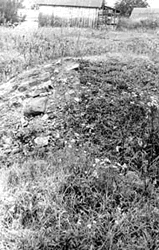
Here stood the synagogue.
Photo taken in 1994.
Young people wanted to join the partisan movement, however the older generation told them that was not needed and said maybe they could pay the Nazis off. With God’s help… They prayed and fasted day after day.
Zalman Peltin ran away from the ghetto with a small child. The child’s name was David. Zalman died in Druya in the middle of the 70’s. David moved to the USA at the end of the 80’s and before that he had worked as a vet in Glubokoye. During the war they were concealed by peasants.
There was another woman from Druya. She was wounded but managed to crawl naked out of the trench and came to a man’s house. His last name was Novitsky. He saved her. Later she hid in forests. She belonged to a well-off family. After the war she moved to the USA.
Doctor Seliber worked in Pogost. He owned an X-ray machine and made good money. The Soviet authorities nationalized the machine. Seliber then moved to Druya together with his sister Raya, a teacher of German. During the execution she read the Germans a whole lecture in their language. They thought she was insane. Brother had left the ghetto earlier.
Adam Brio was a messenger between a partisan brigade and the Druya ghetto.
In 1942-1943 many Jews settled on a swamp. I was also hiding on a swamp and once found out that on Yelna swamp there was a Jewish camp consisting of about 50 families. They were living in the middle of the swamp, found a dry location, built shelters. They were armed and went to get food in villages. They had gold and jewelry.
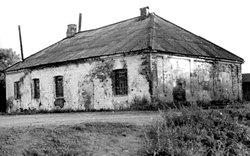
Former Jewish prayer house. In 1994 – a bathhouse.
My relative Eli Kalmanovich was in that camp. There were the Kozliner brothers from Luzhki. Later I, together with about 80 other people, joined the camp and it started to develop as partisan movement. It was the summer of 1943.
From Abram Brio’s letter, written to me from Jerusalem on September 22nd, 1994.
The ghetto in Druya was formed on April 14th, 1942 and consisted of Jews from smaller ghettos – Druysk, Leonpol and some other villages. My family (father, mother, sister and brother) were cramped into a tiny room at a hotel, which contained 36 families all in all. The hotel had only one kitchen, people were running out of food; there were problems with heating. Most of the men were working on the railway.
The ghetto was located between the Dvina and Druyka rivers and formed a triangle. The third side could be easily controlled by a few armed people. The possibilities to escape, therefore, were rather small.
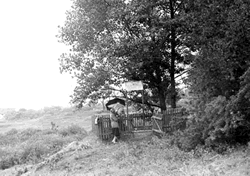
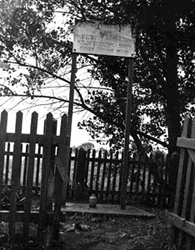
This is what the execution place of Druya Jews looked like at the end of the 1990’s.
Very few people in the ghetto were armed. Some young people attempted to buy weapons. Sema Weinshtein bought a rifle for ten golden rubles. During the ghetto liquidation he was shooting back to the last cartridge (he had only 8). Some other people had weapons, too.
Several days before the liquidation some people left at night to stay in the forest. One of the Nazi policemen let us know that groups of Nazis had been sent to all the ghettos for liquidation.
I personally took 8 men and 14 women out of Druya.
In April, 1943 the first partisans appeared between Disnensky and Miorsky regions. They were joined by a considerable group of Jewish partisans who were hiding on swamps.
There were a lot of Jews who were willing to join the partisan movement. However, only armed people were accepted. Still, some were lucky to stay as shoemakers, tailors, nurses.
How did I get a gun? The part of the railway Bigosovo-Drissa (now Verkhnedvinsk) was guarded by the French. In the evenings they came to Sloboda to have a drink. I took three Jewish men (Abram and Meir Krivitskys and Zelik Goldshtein) and after midnight, when the French were wasted drunk, we easily took their weapons. Even my sister got a gun. All of us were accepted to the 6th brigade.
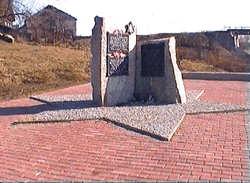
Memorial on the place of execution of Druya Jews.
Only sometimes I spent nights at the Druya ghetto at my parents’ house.
After the liquidation of the ghettos in Miory, we were guarding the roads leading to Druya to see in advance when Nazis would start arriving. However, the signal that the ghetto was being surrounded came too late. There were small chances of escape. Some people tried to swim across the Druyka River, but Nazi policemen were waiting for them on the opposite bank. Arik Levinson managed to swim across, tore out a gun from a policeman, but was immediately shot by another policeman. Shlema Musin started shooting from his pistol and was lucky to escape unharmed.
Nazis were taking all the Jews to a big old synagogue; a grave was already being prepared nearby. Groups of 20 people were taken to the trench, men and women separately. The execution was carried out by Joseph Pukhovsky, Alexander Sinyavsky and Mavtsen. Nazis only gave orders and searched women’s clothes for jewelry.
The big synagogue was set on fire by the Nazis. Some people claim that a woman, whose last name was Peltina, was the one to set it on fire. There are those, who believe she did that in order to help people run away in all the smoke. Others say she wanted to revenge her husband, who had escaped the night before. By the way he (Zalman) survived. It is a fact that the fire started from the Peltins’ house.
Quite a few ghetto prisoners saved themselves, among them Shlema Zaidlin and his son Boris, Luba from Potashnia village with her four-year-old son Meir, Taiba Mareno (now Iona Pliskin), brother and sister Vigdergaus.